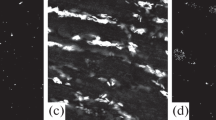Summary
The removal of the acetylcholine receptors (AChRs) from the surface of muscle cells serves as an important mechanism in the regulation of the AChR turnover rate. Our previous studies have shown that cultured myotubes contain coated pits and vesicles bearing α-bungarotoxin (αBTX)-binding sites (Bursztajn 1984; Bursztajn and Fischbach 1984). In this study we have used αBTX conjugated to horseradish peroxidase (HRP) and quantitative electron microscopy to determine the intracellular pathway(s) of acetylcholine receptors during the internalization process. To accomplish this, cultured rat myotubes were incubated with αBTX-HRP at 4° C after which cells were washed and incubated at 37° C for 0 min to 2 h. After warming the cells, coated pits, coated vesicles and smooth membraned vesicles containing the peroxidase reaction product were present. A threefold increase in coated vesicles containing the reaction product was observed 1 min after warming the cells. The number of smooth-membraned vesicles remained constant at this time point. However, 5 to 15 min after warming the cells, a fivefold increase in the number of smooth membraned vesicles was observed. After 1 h at 37° C the reaction product was present in the lysosomal like bodies, but was not observed in the Golgi complex or the small coated vesicles associated with the Golgi complex. Our observations indicate that there is a size segregation between those coated vesicles containing αBTX-HRP reaction product and those in which reaction product is absent. Our studies also suggest that within minutes of AChR internalization coated vesicles lose their coat and become smooth-membraned vesicles.
Similar content being viewed by others
References
Ashwell G, Morell AG (1977) Membrane glycoproteins and recognition phenomen. Trends Biochem Sci 2:76–78
Bleil JD, Bretscher MS (1982) Transferring receptor and its recycling in HeLa cells. EMBO J 1:351–355
Bretscher MS, Thomson JN, Pearse BMF (1980) Coated pits act as molecular filters. Proc Natl Acad Sci USA 77:4156–4159
Bursztajn S (1984) Coated vesicles are associated with acetylcholine receptors at nerve-muscle contacts. J Neurocytol 13:503–518
Bursztajn S, Fischbach GD (1984) Evidence that coated vesicles transport acetylcholine receptors to the surface membrane of chick myotubes. J Cell Biol 98:498–506
Bursztajn S, Libby P (1981) Morphological changes in cultured myotubes treated with agents that interfere with lysosomal function. Cell Tissue Res 220:573–588
Bursztajn S, McManaman J, Appel SH (1984) Organization of acetylcholine receptors clusters in cultures rat myotubes is calcium dependent. J Cell Biol 98:507–517
Bursztajn S, Berman SA, McManaman JL, Watson ML (1985) Acetylcholine receptors at clustered and diffuse domains on cultured myotubes. J Cell Biol 101:104–111
Dautry-Varsat A, Ciechanover A, Lodish HF (1983) pH and the recycling of transferrin during receptor-mediated endocytosis. Proc Natl Acad Sci USA 80:2258–2262
Geuze HJ, Slot JW, Strous GJAM, Lodish HF, Schwartz AL (1983) Intracellular site of asialoglycoprotein receptor-ligand uncoupling: Double-label immunoelectron microscopy during receptor-mediated endocytosis. Cell 32:277–287
Goldstein JL, Anderson RGW, Brown MS (1979) Coated pits, coated vesicles and receptor-mediated endocytosis. Nature 279:679–685
Gordon P, Carpentier JL, Cohen S, Orci L (1978) Epidermal growth factor: Morphological demonstration of binding internalization and lysosomal association in human fibroblasts. Proc Natl Acad Sci 75:5025–5029
Haigler HT, McKanna JA, Cohen S (1979) Direct visualization of the binding and internalization of a ferritin conjugate of epidermal growth factor in human carcinoma cells A 431. J Cell Biol 81:382–395
Helenius A, Mellman I, Wall D, Hubbard A (1983) Endosomes. Trends Biochem Sci July, 245–250
Huet C, Ash JJ, Singer SJ (1980) The antibody-induced clustering of endocytosis of HLA antigens on cultured human fibroblasts. Cell 21:429–438
Ishikawa H (1968) Formation of elaborate networks of T-system tabules in cultured skeletal muscle with special reference to the T-system formation. J Cell Biol 38:51–66
Kaplan A, Achord DT, Sly WS (1977) Phosphohexosyl components of lysosomal enzyme are recognized by pinocytosis receptors on human fibroblasts. Proc Natl Acad Sci USA 74:2026–2030
Klausner RD, Ashwell G, Renswoude J, van Harford JB, Bridges KR (1983) Binding of apotransferrin to K 562 cells: Explanation of the transferrin cycle. Proc Natl Acad Sci USA 80:2263–2266
Maxfield FR (1982) Weak bases and ionophores rapidly and reversibly raise the pH of endocytic vesicles in cultured mouse fibroblasts. J Cell Biol 95:676–681
Neufeld EF, Ashwell G (1980) Carbohydrate recognition systems for receptor-mediated pinocytosis. In: The Biochemistry of Glycoproteins and Proteoglycans, (Lennarz W.J., ed.), New York: Plenum Press, pp 241–266
Rodewald RJ (1980) Distribution of immunoglobulin G receptors in small intestine of the young rat. J Cell Biol 85:18–32
Schiaffino S, Cantini M, Sartore S (1977) T-system formation in cultured rate skeletal tissue. Tissue Cell 9:437–446
Schlessinger S, Schechter Y, Cuatrecasas P, Willingham MC, Pastan I (1978) Direct visualization of binding, aggregation and internalization of insulin and epidermal growth factor on living fibroblastic cells. Proc Natl Sci USA 75:2659–2663
Sly WS, Fischer HD (1982) The phosphomannosyl recognition system for intracellular and intercellular transport of lysosomal enzymes. J Cell Biochem 18:67–85
Tycko B, Maxfield FR (1982) Rapid acidification of endocytic vesicles containing α2 macroglobulin. Cell 28:643–651
Tycko B, Keith CH, Maxfield FR (1983) Rapid acidification of endocytic vesicles containing asialoglycoprotein in cells of a human hepatoma line. J Cell Biol 97:1762–1776
Willingham MC, Pastan I (1980) The receptosome: An intermediate organelle of receptor-mediated endocytosis in cultured fibroblasts. Cell 21:67–77
Willingham MC, Maxfield FR, Pastan I (1979) Alpha2 macroglobulin binding to the plasma membrane of cultured cells: Diffuse binding followed by clustering in coated regions. J Cell Biol 82:614–625
Author information
Authors and Affiliations
Rights and permissions
About this article
Cite this article
Bursztajn, S., Nudleman, H.B. & Berman, S.A. Coated and smooth vesicles participate in acetylcholine receptor transport. Cell Tissue Res. 248, 535–540 (1987). https://doi.org/10.1007/BF00216481
Accepted:
Issue Date:
DOI: https://doi.org/10.1007/BF00216481



